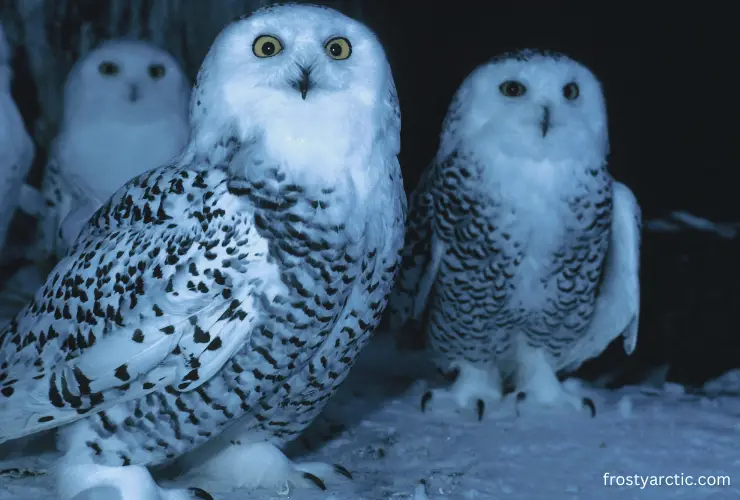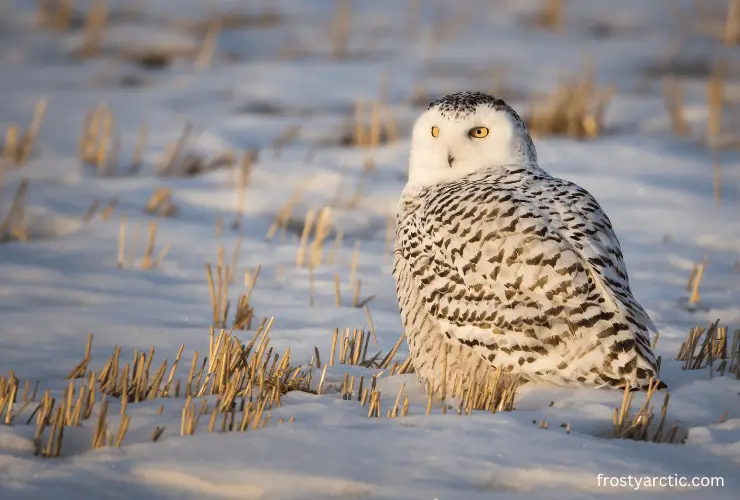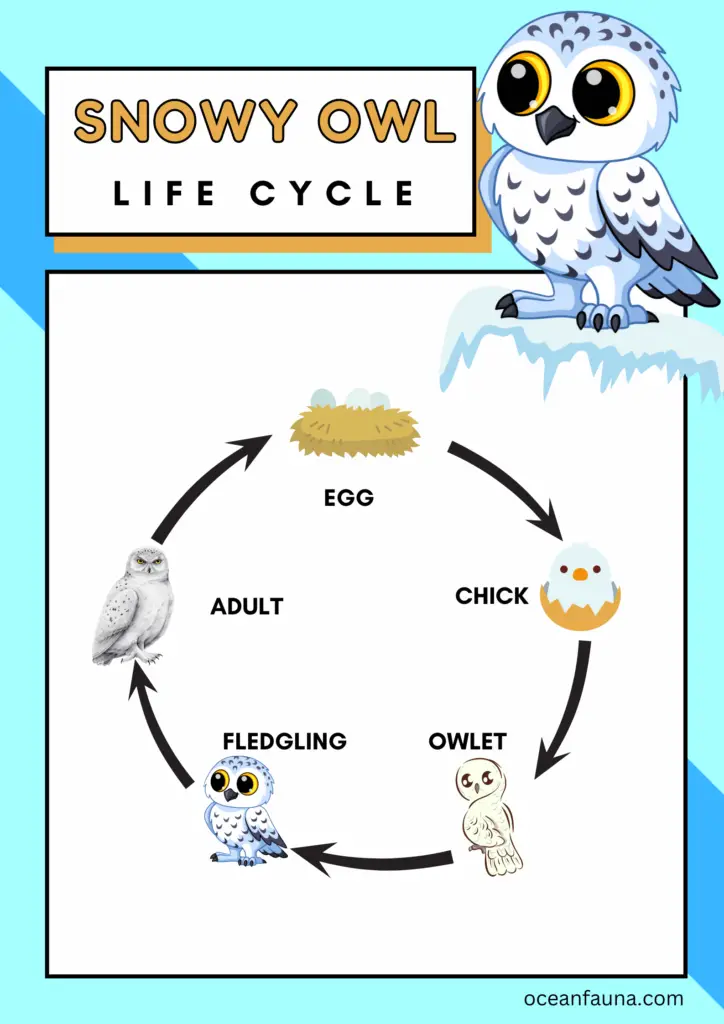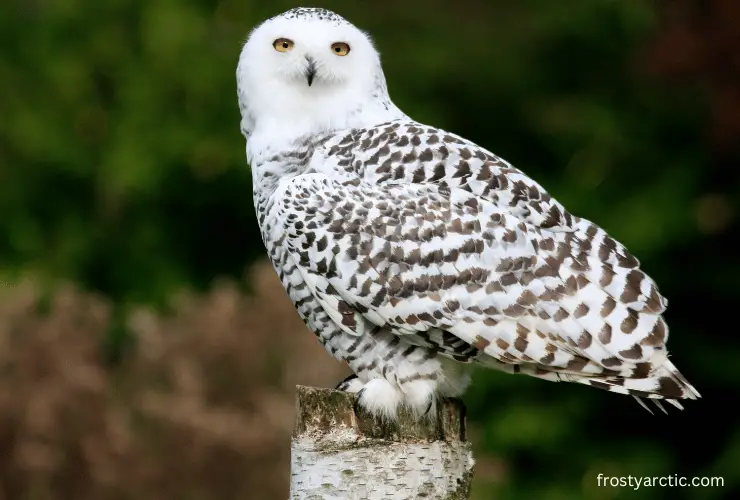Snowy owls can live from 10 to 20 years or even longer. In the wild, they live for 10 years. However, they can survive in captivity for up to 28 years. They can live longer in captivity because there is always food available and no danger from predators.
Hunting, habitat loss, food shortages, and the harsh tundra climate all pose threats to their survival. Despite focusing on their vulnerabilities, these large owls are real survivors.
Let’s give validation to our study with an authentic example. Research on Bylot Iceland involved studying two dozen female owls. The study revealed that their survival rates ranged from 85% to 92% from one year to the next. That’s really impressive! Additionally, enthusiasts and the general public find snowy owls stunning and favorite birds.
One of the biggest birds in the world, snowy owls are fascinating to study because of how long they live. Here we will address each fact related to the topic. Let’s learn how long snowy owls live and why their population declines over time.
How Long Do Snowy Owls Live in The Wild?

There needs to be more information about the true and exact longevity data of snowy owls. But still, you will find enough studies that report that these owls can live for more than 10 years, especially in the wild. Many banded snowy owls have lived for twenty years or longer, as we have already mentioned.
According to the Chesapeake Bay Program study, here are a few examples that prove that some banded snowy owls live longer. A female snowy owl was over twenty years old when caught in Alberta, Canada, in 2013. Another banded snowy owl (female) was 23 years and 10 months old in Massachusetts. ~ Source
The longevity of snowy owls depends on weather conditions, especially during winter. Those are the good years when their prey, like voles and rodents, are abundantly available. The survival rate of adults is absolutely 100% in such years.
Also, the success rate of nesting is very high. According to one EU study, it is more than 90%. Approximately 40 – 80% of snowy owls successfully reach the stage of fledging (the stage of growth with fully developed feathers and wings).
How Long Do Snowy Owls Live in Captivity?
Many anecdotes about tundra owls depict that they live 20 – 30 years in captive environments. One of the snowy owls lived around 28 years in captivity. It was an incident recorded in Switzerland.
Another snowy owl lived for more than 30 years in Ontario. This snowy owl was living in a captive environment (According to the Owl Rehabilitation Foundation, Vineland, Ontario). The owl laid many eggs and died due to the West Nile Virus.
How Do Most Snowy Owls Die?
Most snowy owl deaths occur when they are young or nestlings. As mentioned before, only 40 to 80% of owlets survive during nesting until they fumble. And it’s different than that because all of them will survive. Most of them die before reaching adulthood. These young birds face threats from predators, parasites, starvation, and diseases.

One of the main issues in the Nordic region (Scandinavia) is black fly parasitism. There is a wide range of unnatural causes for which most birds die. These are the birds that survived the threats and reached adulthood. According to the study on the northern Great Plains, we found the following facts: ~ source
“A large number of traumas killed approximately 81% of the seventy-plus snowy owls. Traumas like collisions and shootings cause most of the deaths of these snowy owls. Likewise, starvation was another trauma that caused 14% of the deaths of snowy owls. Shootings are also accountable for the deaths of nearly 25% of snowy owls in British Columbia.
Once, the USGS banding lab found 438 banded snowy owls. Out of 438 birds, one hundred and fifty (34.2%) were recorded as dead due to unidentified reasons, while fifty-two (11.9%) were confirmed to have been shot by guns. What happened to the remainders? They died due to a mix of reasons like starvation, collisions, diseases, and other miscellaneous causes.”
A sudden drop in the population of voles and lemmings also causes severe levels of starvation in snowy owls. However, it’s quite surprising that starvation only causes 10 to 20% of snowy owls’ deaths. Other reasons contribute more than starvation to the decline of snowy owls.
It’s worth considering that the exact causes of death of snowy owls depend on the specific location and population of owls. Researchers are continuously studying and monitoring these birds to better understand the factors influencing their survival. Conservation efforts aim to mitigate these threats and protect snowy owls in their habitat.
How Rare Is a Snowy Owl?
Snowy owls are rare species of owl. They are so rare that the IUCN Red List has marked their Population Status as “vulnerable (VU)“. However, they are still listed as “Least Concern“. However, Population Trends frequently report that the country’s population is “Decreasing” every day.
The population size of snowy owls is 28,000, according to the IUCN Red List. It means only 28,000 snowy owls are present in this world. The European populace comprises 700-2,300 pairs, translating to 1,400-4,600 grown individuals.
Moreover, this population size decreases and increases sometimes. The report also says these snowy owls are mature individuals. It means they are not juveniles or adults. ~ Source
Snowy owls are not endangered, but numerous human activities threaten their population. Collisions with vehicles, wire fences, power lines, and poles are causing many deaths. Illegal hunting and getting caught up in fishing equipment are also other threats that are decreasing the population of these beautiful birds.
Life Cycle of Snowy Owl

The following table best describes the life cycle of a snowy owl: ~ Source
| Life Cycle | Description | |
| 1. | Eggs Stage | Female snowy owls take 2 days to lay 3 to 11 eggs. They sit on eggs for 30 to 35 days to incubate them. |
| 2. | Chick Stage | Chicks come out of eggs after 32 to 35 days. This stage is also known as the hatching stage. Both parent owls take care of chicks for 15 days or a month. |
| 3. | Owlet Stage | Now comes the growth stage. The little chicks become owlets. The owlets try to come out of their nests to get a know-how of their surroundings. Their parents take care of them side-by-side. They also continue to give them food for 4 to 7 weeks until they start hunting themselves. |
| 4. | Fledgling Stage | Now the fledgling stage comes when little owlets are ready to fly and touch the skies. After wandering here and there, they are ready to migrate towards other places on their own. |
| 5. | Adult Stage | The adult stage is the green age of a snowy owl. They live their lives with competence. They know how to hunt and find mates to live their life together. In this stage, the adult owls are ready to reproduce. |
FAQs
Can a snowy owl live in the tundra?
Absolutely yes. They mainly live in the tundra regions of the Arctic. They live on grasslands. Treeless tundra regions are their homes, but they migrate when they think they’ll die due to the winters and scarcity of food.
How old is the oldest snowy owl?
The oldest snowy owl was 30 years old. The owl remained in captivity for 30 years at the Owl Rehabilitation Foundation, Vineland, Ontario. It would have lived longer but died due to the virus. So, the oldest snowy owls can live from 25 to 30 years, according to the records.
What’s the average lifespan of snowy owls?
According to the study of BioKids’ writers, the average lifespan of a snowy owl is 201 months. The oldest-known Tundra owls that live in the wild can only live 9 years and 5 months. Many of them reach 10 years old. However, if they live in captivity (with a caretaker or an owner), they can live 28 to 30 years. Many other studies show that snowy owls can live from 33 to 35 years in captivity. ~ Source
How long do snowy owls live without food?
Snowy owls have considerable subcutaneous fat (approximately 19-22 mm) in their bodies throughout the winter season. According to a study conducted by Vos in 1998, they have the ability to live 24-40 days without consuming any food.
What is the main cause of death of snowy owls?
According to the study, poisoning is one of the main causes of the deaths of snowy owls. Rodents are mostly poisoned by people and if owls eat them, they are also poisoned. Rodents are the main food item for snowy owls. Also, rodents are mostly poisoned because they can cause a mess in people’s houses and living areas. It is recommended to use traps for rodents instead of poison.
Conclusion
So, the tale of the great white owl’s lifespan has come to an end. Its variant lifespan depends on various factors that we have discussed above. They can live longer if we continue to appreciate and protect them. Only in this way will our children and grandchildren also behold their beauty.
You can ask our analysts and experts if you have any other questions regarding snowy owls’ lifespan and life cycle. They would be happy to answer all of your queries.
Sincere thanks for reading our informative article full of delightful facts!



3 thoughts on “How Long Do Snowy Owls Live?”